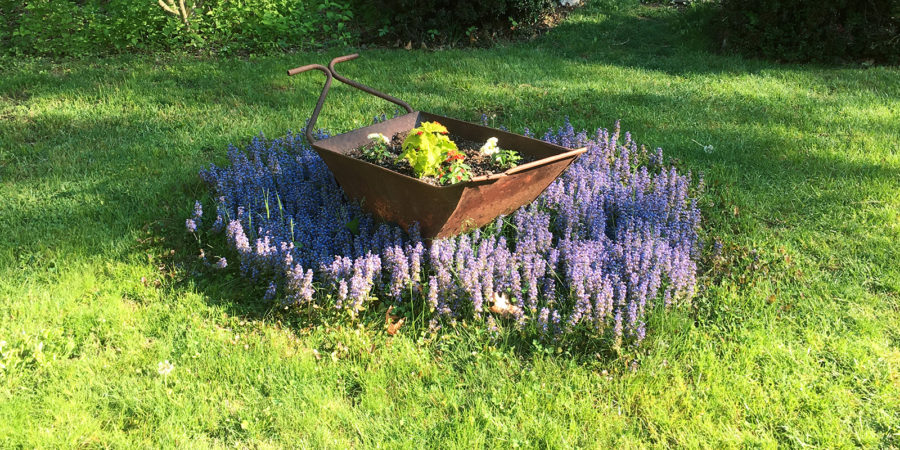Small patches of white, yellow, blue and violet flowers bloom throughout the year. Pickerel Frogs and Spring Peepers hop out of my way as small butterflies and bees float slowly front plant to plant. This is some of the wildlife I see as I’m walking across our lawn.
It’s mid-April and still cold here in Connecticut. Daffodils, crocus, snowdrops and hellebores are blooming but not much else at the moment. However, our lawn is showing signs of coming alive from its winter dormancy. Not the grass, but, many of the other plants that are interspersed within our lawn. Mosses, violets, ajugas and others are growing and painting the lawn in different shades of green.

Top (left to right) Ajuga; Peat Moss; Woolly Thyme. Bottom (left to right) Violet; Indian Strawberry; Dandelion.
When we moved into our house in 1998, the lawn, and the entire yard for that matter, was a mess. Brown patches and dried grass areas covered the front and back yards. We initially hired one of the “natural” lawn services that use organic treatments to encourage grass to take root. After a year or so, the lawn began to look better, but still, in the dry, hot summer, it had patches of dead grass here and there.
I began reading about creating lawns that were beneficial to wildlife and researching do-it-yourself organic lawn maintenance and techniques. There’s a lot of information out there about the “best” ways to treat your lawn and discovered that an all grass lawn is not wildlife friendly.
The first thing I did was cut the lawn higher — about two and a half to three inches. This helps the root system of the grass to grow stronger and become more draught tolerant. I stopped using any weed killing products on the lawn (including organic) and let nature take over, allowing plants of any kind (just about) to grow and take their place in the lawn. Within a couple of years, I noticed the areas that once dried out in the dog days of summer stayed much greener. And the hardy “naturals” took hold where grass would otherwise struggle.
FACT: When mowing your lawn use a mulching blade. The clippings will fall to the base of the lawn adding organic matter and nutrients back into the soil.
My father-in-law visited a year or so after I began this approach. He was an avid golfer and had a lawn that was as tightly manicured as a fairway. About a second after he arrived he looked over the yard and said, “ Looks like the lawn needs cutting.” I had actually cut my lawn the day before he arrived!

As time went on, more and more types of vegetation began growing within the grass. Our “lawn” has truly become an eco-system. The wide variety of plants have enticed wildlife of all kinds — bees, frogs, toads, rabbits, birds and more. It’s become a center of wildlife activity.
Of course, I still go around in the spring digging up as many dandelions as my back will allow. But I do leave enough to entice Honey and other types of bees into the yard. Many of the plants in the lawn flower such as violets, ajugas and clovers, and other plants that I can’t yet identify. I do want to make certain I haven’t allowed invasive plants to take hold and keep natives from finding their place.
I encourage you not to become too fixated on the sterile, grass only, lawn. Neighbors, and neighborhoods, can certainly dictate how much you can get away with, but there are ways to make the lawn a more eco-friendly place for wildlife — without anyone knowing.
OBSERVATION: I did attempt to create a wild flower garden on my front lawn last summer — a circular area that I seeded and simply let grow. My neighbors, friends of ours, referred to it as blight. I soon afterward cut it back. Oh well, it was worth a try.
